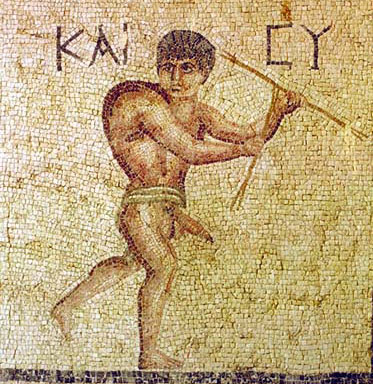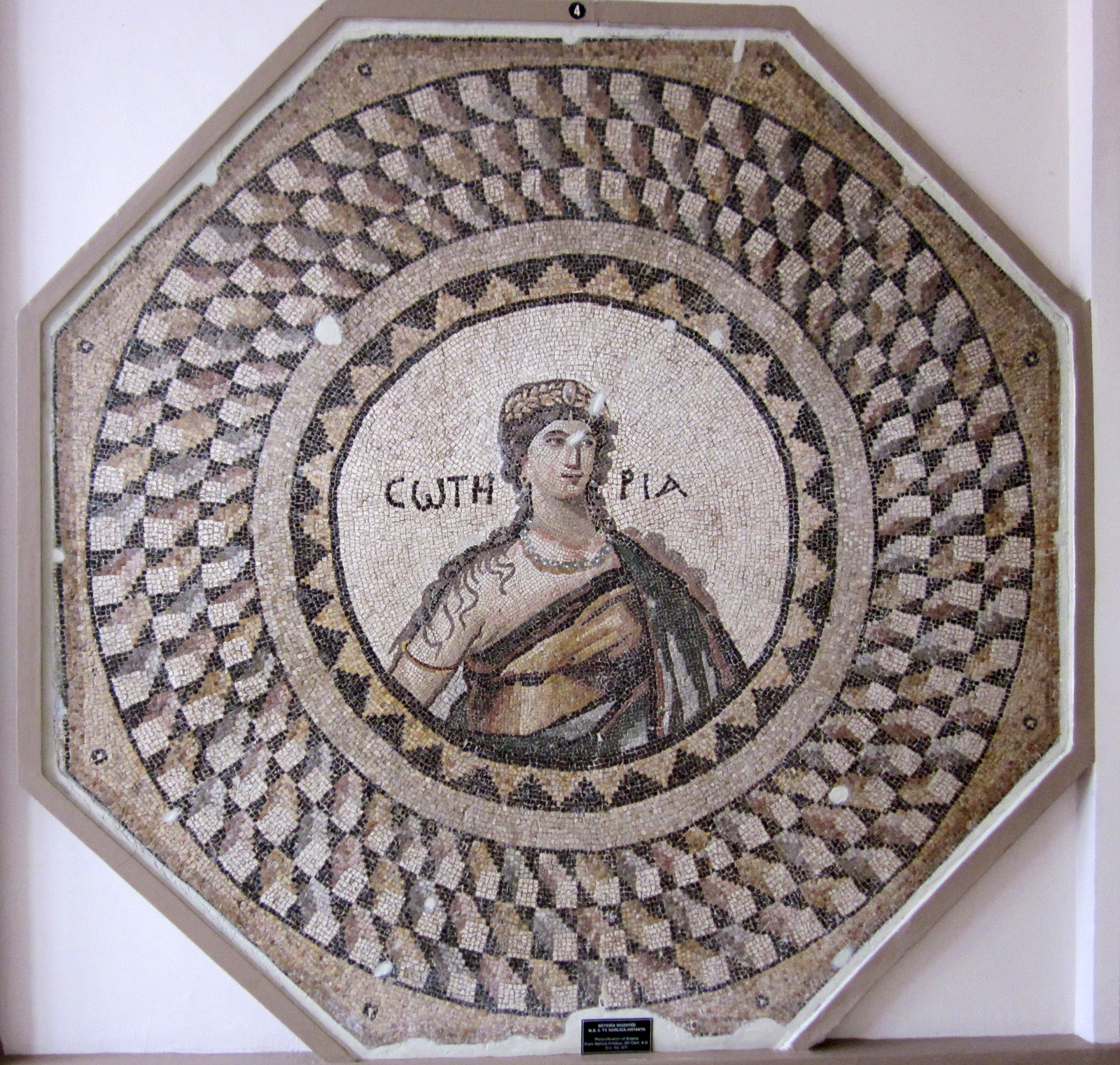|
Tychon
Tychon or Tykhon (Τύχων, ''Tykhōn'' is the name of two minor deities in Greek mythology. One was a daemon of fertility associated with Phales, Priapus and his mother Aphrodite.''Dictionary of Greek and Roman Biography and Mythology''Tychon/ref> He and his companions Orthanês and Konisalos were associated with Dionysos or with the Hermai (phallic statues of Hermes). Although nowhere stated, his father was likely one of these two gods, who were half-siblings, sons of Zeus. Another Tychon, a god of chance or accident, is mentioned by the geographer Strabo, who stated that “Priapos... resembles the Attic deities Orthannes, Konisalos (Conisalus), Tykhon (Tychon), and others like them.”Strabo, ''Geography'' 13. 1. 12 (trans. Jones) He was worshipped at Athens. The only known depiction of Tychon is now in Hatay Archaeology Museum, Turkey Turkey ( tr, Türkiye ), officially the Republic of Türkiye ( tr, Türkiye Cumhuriyeti, links=no ), is a list of transcontinen ... [...More Info...] [...Related Items...] OR: [Wikipedia] [Google] [Baidu] |
List Of Fertility Deities
A fertility deity is a god or goddess associated with fertility, sex, pregnancy, childbirth, and crops. In some cases these deities are directly associated with these experiences; in others they are more abstract symbols. Fertility rites may accompany their worship. The following is a list of fertility deities. African *Ala, Igbo goddess of fertility *Asase Ya, Ashanti earth goddess of fertility *Deng, Dinka sky god of rain and fertility *Mbaba Mwana Waresa, Zulu goddess of fertility, rainbows, agriculture, rain, and bees *Oshun (known as ''Ochún'' or ''Oxúm'' in Latin America) also spelled Ọṣun, is an orisha, a spirit, a deity, or a goddess that reflects one of the manifestations of God in the Ifá and Yoruba religions. She is one of the most popular and venerated orishas. Oshun is the deity of the river and fresh water, luxury and pleasure, sexuality and fertility, and beauty and love. She is connected to destiny and divination. Ancient Egyptian *Amun, creator-god, a ... [...More Info...] [...Related Items...] OR: [Wikipedia] [Google] [Baidu] |
Strabo
Strabo''Strabo'' (meaning "squinty", as in strabismus) was a term employed by the Romans for anyone whose eyes were distorted or deformed. The father of Pompey was called "Pompeius Strabo". A native of Sicily so clear-sighted that he could see things at great distance as if they were nearby was also called "Strabo". (; el, Στράβων ''Strábōn''; 64 or 63 BC 24 AD) was a Greek geographer, philosopher, and historian who lived in Asia Minor during the transitional period of the Roman Republic into the Roman Empire. Life Strabo was born to an affluent family from Amaseia in Pontus (in present-day Turkey) in around 64BC. His family had been involved in politics since at least the reign of Mithridates V. Strabo was related to Dorylaeus on his mother's side. Several other family members, including his paternal grandfather had served Mithridates VI during the Mithridatic Wars. As the war drew to a close, Strabo's grandfather had turned several Pontic fortress ... [...More Info...] [...Related Items...] OR: [Wikipedia] [Google] [Baidu] |
Cult Of Dionysus
The cult of Dionysus was strongly associated with satyrs, centaurs, and Silenus, sileni, and its characteristic symbols were the Bull (mythology), bull, the Serpent (symbolism), serpent, tigers/leopards, ivy, and wine. The Dionysia and Lenaia festivals in Athens were dedicated to Dionysus, as well as the phallic processions. Initiates worshipped him in the Dionysian Mysteries, which were comparable to and linked with the Orphic Mysteries, and may have influenced Gnosticism. Orpheus was said to have invented the Mysteries of Dionysus.Apollodorus (Bibliotheca (Pseudo-Apollodorus), Pseudo Apollodorus)''Library and Epitome'', 1.3.2 "Orpheus also invented the mysteries of Dionysus, and having been torn in pieces by the Maenads he is buried in Pieria (regional unit), Pieria." The Cult (religious practice), cult of Dionysus traces back to at least Mycenaean Greece, since his name is found on Mycenaean Greek, Mycenean Linear B tablets as ''(di-wo-nu-so)''. Dionysus is often shown ridin ... [...More Info...] [...Related Items...] OR: [Wikipedia] [Google] [Baidu] |
Phallic Symbols
A phallus is a penis (especially when erect), an object that resembles a penis, or a mimetic image of an erect penis. In art history a figure with an erect penis is described as ithyphallic. Any object that symbolically—or, more precisely, iconically—resembles a penis may also be referred to as a phallus; however, such objects are more often referred to as being phallic (as in "phallic symbol"). Such symbols often represent fertility and cultural implications that are associated with the male sexual organ, as well as the male orgasm. Etymology The term is a loanword from Latin ''phallus'', itself borrowed from Greek (''phallos''), which is ultimately a derivation from the Proto-Indo-European root *''bʰel''- "to inflate, swell". Compare with Old Norse (and modern Icelandic) ''boli'' "bull", Old English ''bulluc'' "bullock", Greek "whale". Archaeology The Hohle phallus, a 28,000-year-old siltstone phallus discovered in the Hohle Fels cave and reassembled in 2005, is ... [...More Info...] [...Related Items...] OR: [Wikipedia] [Google] [Baidu] |
Greek Gods
The following is a list of gods, goddesses, and many other divine and semi-divine figures from ancient Greek mythology and ancient Greek religion. Immortals The Greeks created images of their deities for many purposes. A temple would house the statue of a god or goddess, or multiple deities, and might be decorated with relief scenes depicting myths. Divine images were common on coins. Drinking cups and other vessels were painted with scenes from Greek myths. Major gods and goddesses Greek primordial deities Titans and Titanesses The Titan gods and goddesses are depicted in Greek art less commonly than the Olympians. File:Eos Memnon Louvre G115.jpg, Eos (Dawn) and the hero Memnon (490–480 BC) File:Ilion---metopa.jpg, Helios in his four-horse chariot (3rd century BC) File:0029MAN-Themis.jpg, Themis, from the Temple of Nemesis (ca. 300 BC) File:Antakya Arkeoloji Muzesi 02366 nevit.jpg, Oceanus wearing crab-claw horns, with Tethys ( Roman-era mosaic) File:Creation Promethe ... [...More Info...] [...Related Items...] OR: [Wikipedia] [Google] [Baidu] |
Fertility Gods
Fertility is the capability to produce offspring through reproduction following the onset of sexual maturity. The fertility rate is the average number of children born by a female during her lifetime and is quantified demographically. Fertility is addressed when there is a difficulty or an inability to reproduce naturally, which is referred to as infertility. Infertility is widespread, with fertility specialists available all over the world to assist mothers and couples who experience difficulties having a baby. Human fertility depends on factors of nutrition, sexual behaviour, consanguinity, culture, instinct, endocrinology, timing, economics, personality, way of life, and emotions. Fertility differs from fecundity, which is defined as the ''potential'' for reproduction (influenced by gamete production, fertilization and carrying a pregnancy to term). Where a woman or the lack of fertility is infertility while a lack of fecundity would be called sterility. Demography In d ... [...More Info...] [...Related Items...] OR: [Wikipedia] [Google] [Baidu] |
Turkey
Turkey ( tr, Türkiye ), officially the Republic of Türkiye ( tr, Türkiye Cumhuriyeti, links=no ), is a list of transcontinental countries, transcontinental country located mainly on the Anatolia, Anatolian Peninsula in Western Asia, with a East Thrace, small portion on the Balkans, Balkan Peninsula in Southeast Europe. It shares borders with the Black Sea to the north; Georgia (country), Georgia to the northeast; Armenia, Azerbaijan, and Iran to the east; Iraq to the southeast; Syria and the Mediterranean Sea to the south; the Aegean Sea to the west; and Greece and Bulgaria to the northwest. Cyprus is located off the south coast. Turkish people, Turks form the vast majority of the nation's population and Kurds are the largest minority. Ankara is Turkey's capital, while Istanbul is its list of largest cities and towns in Turkey, largest city and financial centre. One of the world's earliest permanently Settler, settled regions, present-day Turkey was home to important Neol ... [...More Info...] [...Related Items...] OR: [Wikipedia] [Google] [Baidu] |
Hatay Archaeology Museum
The Hatay Archaeology Museum ( tr, Hatay Arkeoloji Müzesi) is the archaeology museum of Antakya, Turkey. It is known for its extensive collection of Roman and Byzantine Era mosaics. The museum is located in Antakya, the main city of Hatay. Construction of the museum started in 1934 on the recommendation of the French archaeologist and antiquities inspector Claude M. Prost. It was completed in 1938 and came under Turkish control in 1939 following Hatay Province#Hatay Province of Turkey, Hatay's unification with Turkey. The museum was opened to the public in 1948 and re-opened in 1975 following renovation and expansion. With 3,500 sqm of mosaics displayed in 10,700 sqm of exhibition space and 32,754 sqm of total indoor space, the museum is claimed to be the largest mosaic museum in the world. Collection Hatay has a rich collection of mosaics dating back to the Hellenistic and to the Roman era in the 2nd and 3rd centuries. They have been found in the ancient cities of Daphne, Sel ... [...More Info...] [...Related Items...] OR: [Wikipedia] [Google] [Baidu] |
Athens (polis)
The city of Athens ( grc, Ἀθῆναι, ''Athênai'' .tʰɛ̂ː.nai̯ Modern Greek: Αθήναι, ''Athine'' or, more commonly and in singular, Αθήνα, ''Athina'' .'θi.na during the classical period of ancient Greece (480–323 BC) was the major urban centre of the notable ''polis'' (city-state) of the same name, located in Attica, Greece, leading the Delian League in the Peloponnesian War against Sparta and the Peloponnesian League. Athenian democracy was established in 508 BC under Cleisthenes following the tyranny of Isagoras. This system remained remarkably stable, and with a few brief interruptions remained in place for 180 years, until 322 BC (aftermath of Lamian War). The peak of Athenian hegemony was achieved in the 440s to 430s BC, known as the Age of Pericles. In the classical period, Athens was a centre for the arts, learning and philosophy, home of Plato's Academy and Aristotle's Lyceum, Athens was also the birthplace of Socrates, Plato, Pericles, Aristoph ... [...More Info...] [...Related Items...] OR: [Wikipedia] [Google] [Baidu] |
Geographica
The ''Geographica'' (Ancient Greek: Γεωγραφικά ''Geōgraphiká''), or ''Geography'', is an encyclopedia of geographical knowledge, consisting of 17 'books', written in Ancient Greek, Greek and attributed to Strabo, an educated citizen of the Roman Empire of Greek descent. There is a fragmentary palimpsest dating to the fifth century. The earliest manuscripts of books 1–9 date to the tenth century, with a 13th-century manuscript containing the entire text. Title of the work Strabo refers to his ''Geography'' within it by several names: * geōgraphia, "description of the earth" * chōrographia, "description of the land" * periēgēsis, "an outline" * periodos gēs, "circuit of the earth" * periodeia tēs chōrās, "circuit of the land" Apart from the "outline", two words recur, "earth" and "country." Something of a theorist, Strabo explains what he means by Geography and Chorography:It is the sea more than anything else that defines the contours of the land (''geōgra ... [...More Info...] [...Related Items...] OR: [Wikipedia] [Google] [Baidu] |
Attica
Attica ( el, Αττική, Ancient Greek ''Attikḗ'' or , or ), or the Attic Peninsula, is a historical region that encompasses the city of Athens, the capital of Greece and its countryside. It is a peninsula projecting into the Aegean Sea, bordering on Boeotia to the north and Megaris to the west. The southern tip of the peninsula, known as Laurion, was an important mining region. The history of Attica is tightly linked with that of Athens, and specifically the Golden Age of Athens during the classical period. Ancient Attica ( Athens city-state) was divided into demoi or municipalities from the reform of Cleisthenes in 508/7 BC, grouped into three zones: urban (''astu'') in the region of Athens main city and Piraeus (port of Athens), coastal (''paralia'') along the coastline and inland (''mesogeia'') in the interior. The modern administrative region of Attica is more extensive than the historical region and includes Megaris as part of the regional unit West Attica, ... [...More Info...] [...Related Items...] OR: [Wikipedia] [Google] [Baidu] |






